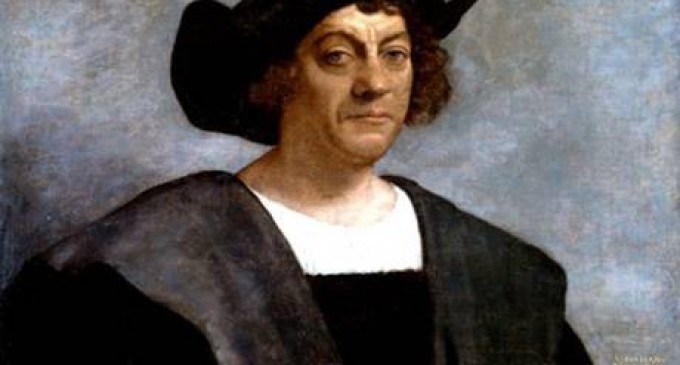
Archaeological investigators believe they have found Christopher Columbus’s flagship, the Santa Maria, off the northern coast of Haiti.
“All the geographical, underwater topography and archaeological evidence strongly suggests that this wreck is Columbus’ famous flagship, the Santa Maria,” states Barry Clifford, the reconnaissance expedition leader and one of America’s top underwater archaeological investigators.
In 1492, Columbus sailed the Santa Maria from southern Spain through the Canary Islands in search of a new western route to Asia.
Columbus reached the Bahamas after 37 days of sailing, but ten weeks later drifted during the night onto a reef off the northern coast of Haiti, with Columbus on board, and had to be abandoned.
Tentatively identifying the wreck as the Santa Maria has been made possible by quite separate discoveries made by other archaeologists in 2003 suggesting the probable location of Columbus’ fort relatively nearby. Armed with this new information about the location of the fort, Clifford was able to use data in Christopher Columbus’ diary to work out where the wreck should be.
An expedition, mounted by his team a decade ago, had already found and photographed the wreck – but had not, at that stage, realized its probable identity.
It’s a current re-examination of underwater photographs from that initial survey (carried out back in 2003), combined with data from recent reconnaissance dives on the site (carried out by Clifford’s team earlier this month), that have allowed Clifford to tentatively identify the wreck as that of the Santa Maria.
The evidence so far is substantial. It is the right location in terms of how Christopher Columbus, writing in his diary, described the wreck in relation to his fort.
The site is also an exact match in terms of historical knowledge about the underwater topography associated with the loss of the Santa Maria. The local currents are also consistent with what is known historically about the way the vessel drifted immediately prior to its demise.
The footprint of the wreck, represented by the pile of ship’s ballast, is also exactly what one would expect from a vessel the size of the Santa Maria.
Using marine magnetometers, side-scan sonar equipment and divers, Mr. Clifford’s team has, over several years, investigated more than 400 seabed anomalies off the north coast of Haiti and has narrowed the search for the Santa Maria down to the tiny area where the wreck, which the team thinks may well be Columbus’ lost vessel, has been found.
The underwater remains of what is thought to be Columbus’s flagship (Brandon Clifford) A re-examination of the photographic evidence taken during the 2003 initial survey of the site by Mr. Clifford and his son Brandon has also provided evidence which is consistent with the vessel being from Columbus’ era – including a probable early cannon of exactly the type known to have been on-board the Santa Maria.
When Clifford and his team returned to the site earlier this month, their intention was to definitively identify the cannon and other surface artefacts that had been photographed back in 2003. But tragically all the key visible diagnostic objects including the cannon had been looted by illicit raiders.
“We’ve informed the Haitian government of our discovery – and we are looking forward to working with them and other Haitian colleagues to ensure that the site is fully protected and preserved. It will be a wonderful opportunity to work with the Haitian authorities to preserve the evidence and artefacts of the ship that changed the world,” said Mr. Clifford.
“I am confident that a full excavation of the wreck will yield the first ever detailed marine archaeological evidence of Columbus’ discovery of America.”
“Ideally, if excavations go well and depending on the state of preservation of any buried timber, it may ultimately be possible to lift any surviving remains of the vessel, fully conserve them and then put them on permanent public exhibition in a museum in Haiti.
“I believe that, treated in this way, the wreck has the potential to play a major role in helping to further develop Haiti’s tourism industry in the future,” he said.
Mr Clifford, who discussed the wreck site with the President of Haiti, Michel Martelly last year, is one of the world’s most experienced explorers of underwater archaeological sites. He has carried out survey work on dozens of historic wrecks in different parts of the world over the past four decades – and was the discoverer and excavator of the world’s first fully verified pirate shipwreck, the Whydah, back in 1984, and more recently discovered Captain Kidd’s flagship off Madagascar.

And here comes all the white people claiming to be Indian and getting all offended . Get over it we had nothing to do with it and historically speaking it’s a great find with much to be learned from it . I’m irish and we were persecuted for years you don’t here us whining every time we get a chance , so get over yourselves . Also of your so into Indian culture why do you drive cars and pollute the earth , that goes against everything they stand for . Just some food for thought .
Some historical events are really amazing but we just have to lean living with them.
Oh and one last thing we give your land back which displaced people who had lived there for years and had nothing to do with it just so you can destroy and pollute the land even more with casino’s ….which brought in.crime , drugs in the hands of sixteen year olds ..I know I saw it happen from the foxwoods casino , so honestly stop blaming us .
BIG DEAL!! The Vikings discovered America long before Columbus did. I’m Norwegian
Just run the vin number
Why is this important ?
Believe is a damn big word !!!
That’s great!
I hope it is true!!!!
Get over it strickland.